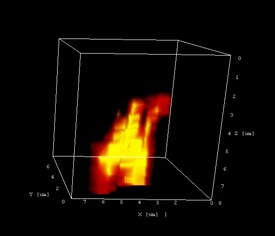Up to now scientists thought that the trace amounts of carbon on the surface of the Moon came from the solar wind. Now researchers at the Carnegie Institution’s Geophysical Laboratory have detected and dated Moon carbon in the form of graphite—the sooty stuff of pencil lead—which survived from the late heavy bombardment era 3.8 billion years ago. The researchers found instances of graphite and a form of rolled graphite called graphite whiskers that could only form in very high temperature reactions initiated by an impact. The discovery also means that the Moon potentially holds a record of the meteoritic carbon input to the Earth-Moon system, when life was just beginning to emerge on Earth. The research is published in the July 2, 2010, issue of Science.

“The Solar System was chaotic with countless colliding objects 3.8 billion years ago,” explained lead author Andrew Steele. “Volatiles—compounds like water and elements like carbon were vaporized under that heat and shock. These materials were critical to the creation of life on Earth. Our team analyzed Moon rocks collected from the Mare Serenitatis area visited by the Apollo 17 mission. In the past, researchers tried to extract the carbon from Moon material, but the only carbon definitively identified came from the solar wind. We used a different technique. We looked at thin rock slices and fresh surfaces using a mapping technique called confocal Raman imaging spectroscopy. This technique identifies minerals and carbon species and their spatial relationship to each other beneath the surface of a sample. We were really surprised at the discovery of graphite and graphite whiskers, we were not expecting to see anything like this.”
The scientists ruled out the possibility that the graphite was a result of contamination, because graphite whiskers, in particular, form under very hot conditions, between 1830° F and 6500° F (1273-3900 Kelvin). They also ruled out that the solar wind was the source, because the particles of graphite and graphite whiskers were much larger than the carbon that is implanted by the solar wind and, while contamination occurred throughout the sample, the graphite was restricted to a discrete blackened area of the sample.
“We believe that the carbon we detected either came from the object that made the impact basin, or it condensed from the carbon-rich gas that was released during impact, said coauthor Francis McCubbin. “The most exciting prospect from the discovery is that we now know that the Moon holds a record of that period and the materials that contributed to the rise of life on Earth.”
“Furthermore, it shows that modern spatially resolved techniques can be used to discover further surprises in the now 40-year-old Apollo collection,” remarked Mihaela Glamoclija another coauthor on the study.
__________________
This work was supported by NASA; ASTEP, SRLIDA, LASER, and MFRP funding programs.
